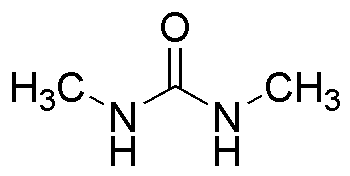1,3-Dimethylurea is widely utilized in research focused on:
- Agriculture: It serves as a nitrogen source in fertilizers, promoting plant growth and enhancing crop yields.
- Pharmaceuticals: This compound is used in the synthesis of various medicinal agents, contributing to the development of new drugs.
- Polymer Science: It acts as a building block in the production of polymers, improving material properties such as strength and durability.
- Biochemistry: Researchers utilize it in studies related to enzyme activity and protein interactions, aiding in the understanding of biological processes.
- Environmental Science: It is employed in the formulation of biodegradable materials, addressing sustainability challenges in various industries.
Informations générales
Propriétés
Sécurité et réglementation
Applications
1,3-Dimethylurea is widely utilized in research focused on:
- Agriculture: It serves as a nitrogen source in fertilizers, promoting plant growth and enhancing crop yields.
- Pharmaceuticals: This compound is used in the synthesis of various medicinal agents, contributing to the development of new drugs.
- Polymer Science: It acts as a building block in the production of polymers, improving material properties such as strength and durability.
- Biochemistry: Researchers utilize it in studies related to enzyme activity and protein interactions, aiding in the understanding of biological processes.
- Environmental Science: It is employed in the formulation of biodegradable materials, addressing sustainability challenges in various industries.
Documents
Fiches de données de sécurité (FDS)
La FDS fournit des informations de sécurité complètes sur la manipulation, le stockage et l’élimination du produit.
Spécifications du produit (PS)
Le PS fournit une description complète des propriétés du produit, notamment sa composition chimique, son état physique, sa pureté et les exigences de stockage. Il détaille également les plages de qualité acceptables et les applications prévues du produit.
Certificats d'analyse (COA)
Recherchez des certificats d'analyse (COA) en saisissant le numéro de lot du produit. Les numéros de lot et de lot se trouvent sur l'étiquette d'un produit, après les mots « Lot » ou « Lot de fabrication ».
Numéro de catalogue
Numéro de lot/série
Certificats d'origine (COO)
Ce certificat d'exploitation confirme le pays dans lequel le produit a été fabriqué, et détaille également les matériaux et composants utilisés et s'il est issu de sources naturelles, synthétiques ou autres sources spécifiques. Ce certificat peut être requis pour les douanes, le commerce et la conformité réglementaire.
Numéro de catalogue
Numéro de lot/série
Fiches de données de sécurité (FDS)
La FDS fournit des informations de sécurité complètes sur la manipulation, le stockage et l’élimination du produit.
DownloadSpécifications du produit (PS)
Le PS fournit une description complète des propriétés du produit, notamment sa composition chimique, son état physique, sa pureté et les exigences de stockage. Il détaille également les plages de qualité acceptables et les applications prévues du produit.
DownloadCertificats d'analyse (COA)
Recherchez des certificats d'analyse (COA) en saisissant le numéro de lot du produit. Les numéros de lot et de lot se trouvent sur l'étiquette d'un produit, après les mots « Lot » ou « Lot de fabrication ».
Numéro de catalogue
Numéro de lot/série
Certificats d'origine (COO)
Ce certificat d'exploitation confirme le pays dans lequel le produit a été fabriqué, et détaille également les matériaux et composants utilisés et s'il est issu de sources naturelles, synthétiques ou autres sources spécifiques. Ce certificat peut être requis pour les douanes, le commerce et la conformité réglementaire.


